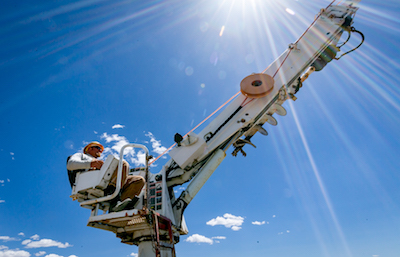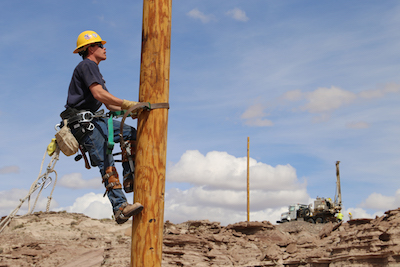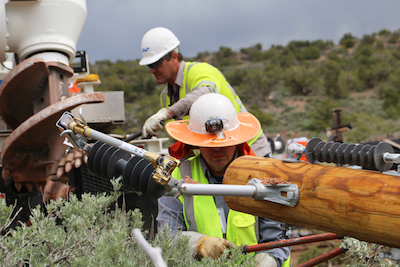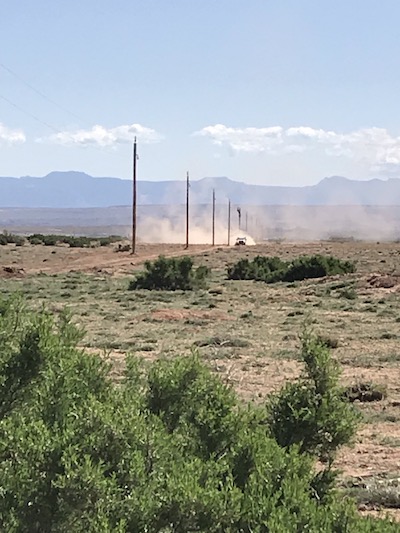In the sacred story of the birth of the Navajo
Nation, the first holy people rose through three worlds before emerging into
the splendor of their homeland in what would become the American Southwest.
They called it the Glittering World.
Their landscape sparkles against brilliant blue
skies, bookended by sunrises and sunsets that turn towering red rock
formations, canyons, mountains, lakes, forests and high desert into majestic
works of art.
But inside thousands of the homes dotting the
Nation's 27,000-square miles, it is dark.
No lights. No working refrigerators or microwave
ovens. No TVs, computers or cell phone chargers. No modern conveniences beyond
what some residents minimally fuel with small generators a couple of hours a
day.
Roughly 15,000 of the 55,000 families living on
the reservation never have had electricity. Their homes comprise 70% of all
dwellings in the United States without it.
But last spring, thanks in large part to IBEW
members, the lights went on in 233 of those homes. Hundreds more will be hooked
up later this year during the second phase of a mammoth project called Light Up
Navajo.
It has been life-changing for the Navajo people
and linemen alike.
"When they turn the first switch and they can
finally use the microwave, the mini fridge, they're crying, we're tearing
up," journeyman lineman Matt Scirpoli said. "I'm so proud I could be
part of it."
Eager to Volunteer
Scirpoli, of Worcester, Mass., Local 486, was among
dozens of IBEW members around the country who traveled in spring 2019 to the
Navajo Nation to work alongside electricians from the Navajo Tribal Utility
Authority.
The territory, larger than West Virginia, sprawls
across the adjoining corners of Arizona, New Mexico and Utah. Roughly 190,000
residents — about two-thirds of the Navajo population — live on the reservation
at any given time.
Density averages 4.2 houses per square mile. But
many are spread farther apart, making the work of installing utility poles and
stringing wire more labor-intensive and time-consuming than is typical for line
crews.
Utilities and municipalities, such as the City of
West Boylston in Massachusetts, where Scirpoli works, paid regular wages and
travel expenses to send eager volunteers, many of them staying two weeks.
Linemen happily worked to exhaustion, 12 to 14 hours a day, usually six days a
week.
Just driving between the secluded worksites could
take two hours or more, sometimes to service a single home. Scirpoli's crew installed
26 poles and 18,000 feet of wire at one isolated property. His Local 486
brother Brian Foley, a journeyman lineman from Sterling, Mass., helped put up
hundreds of poles along a 12-mile stretch to bring power to a cluster of 30
homes.
"We were running pole lines across the desert
to serve just a few houses," Foley said. "The best day we had was 35
poles."
Some utilities sent workers to the region in
company vehicles to supplement the NTUA crews' equipment. Still, there weren't
enough bucket trucks to go around, and linemen found themselves scrambling up
and down poles. It was more climbing than most of them had done in years, but
it came with a fringe benefit.
"If you got up on a pole on a mesa, the views
were amazing," said journeyman lineman Todd Johnson of Rockford, Ill.,
Local 196. "The landscape varies so much. There's a lot of openness, a lot
of sand, a lot of rock mesa, also in areas it was a little bit
mountainous."
Johnson and three of his IBEW brothers at Rochelle
Municipal Utilities were on scene in March, two weeks earlier than other crews.
"We were kind of there to test things
out," he said. "There were maybe a few minor bugs, but nothing that
didn't get worked out in a hurry, like not always having enough material on
site."
He and other volunteers had nothing but praise for
the meticulous, highly skilled NTUA linemen they worked alongside.
"They're very well trained," Johnson said. "They have a
fantastic apprenticeship program. If someone can't make a class, they bring a
tutor out to them because this place is so vast."
A Different World

|
Lineman Corey Smith in a SMUD line truck, one of the vehicles that he and his Local 1245 brothers drove to Arizona from Sacramento, Calif.
Photo by John Storey, courtesy of Local 1245
|
On their own, tribal crews hook up an average of
474 homes a year. "If NTUA stayed its course, 50 years from now we'd still
be connecting people," NTUA General Manager Walter Haase said.
Haase's long career in energy management began as
a summer helper with Chicago Local 134, where some of his many family members
in the building trades are members.
A past chair of the American Public Power
Association, Haase has been speaking to utilities for years about the hurdles
to fully powering the impoverished Navajo Nation, from exorbitant costs to
years of red tape. Meanwhile, many Navajo families are enduring Third-World
conditions.
"We all forget what it's like not to have
electricity or running water," Haase said. "Navajo families use coal
right out of the mine or wood from the forest to heat their homes and cook
their food, and neither one is a very healthy environment. If you don't have
electricity, you don't have refrigeration. You have no electricity to move water.
"They have 250-gallon plastic water tanks on
a pickup or trailer and at least three times a week they drive an hour, hour
and a half, to get water," he said. "The same time, they're going to
the store. There are no Walmarts or Targets. In most cases they're going to a
gas station with a convenience store. And they're going to have to buy ice,
which only lasts for a short period of time."
As Haase made the rounds of APPA conferences,
stunned utility leaders offered to help, planting the seeds for what's become
Light Up Navajo.
"APPA has a mutual aid program that sends
electric crews to areas hit by natural disasters like hurricanes and
tornadoes," he said. "It was suggested that the same model could be
used to deploy crews to the Navajo Nation."
Linemen who made the trip left Navajo families
with more than electric power, Haase said.
"In my opinion, the more important thing than
these people getting electricity, was that they got to see that other American
people cared enough about them to stop what they were doing in their lives and
come help them."
'It Really Humbles You'

|
Chris Cox was one of four Rockford, Ill., Local 196 members from Rochelle Municipal Utilities who headed to the Navajo Nation two weeks before other crews to help NTUA with a test run of the Light Up Navajo program.
Photo courtesy of APPA via NTUA.
|
IBEW volunteers witnessed the hardships Haase
described and many more.
"It definitely opened my eyes,"
journeyman lineman Chris Worth said. "They're telling stories of driving
two hours a day to get ice or food, and you're thinking about the complaining
we do about driving to Safeway in traffic. It really humbles you."
Worth was one of five members of Vacaville,
Calif., Local 1245 who headed to Arizona in late April from the Sacramento
Municipal Utility District, traveling in trucks SMUD lent to the cause.
The houses they serviced were pre-wired — some of
them modular homes that came with wiring; others traditional Navajo hogans with
thick earthen walls that had to be adapted. "Some of these houses, they'd
had the wiring installed a long time ago," said journeyman Corey Smith of
the Local 1245 crew. "One woman was in tears, telling us, 'We've been
waiting for nine years.'"
Without minimizing the frustration their regular
customers feel when the power goes out, IBEW linemen couldn't help but return
home with a new perspective. Confronted by a man irate about a maintenance
outage a few months later, Smith said, "I was thinking, 'Dude, you have no
idea.'"
It was a lesson Worth repeated for days with his
teenage daughter. "Probably a week's worth of lectures," he said with
a laugh. "Here we have everything right at our fingertips. She doesn't
understand how much harder life is for the Navajos, how nothing is really
convenient."
Huge Challenges

|
Linemen Jayme Baranek and Mario Lizarraga, foreground, prepare to install a pole. They were among 30 members of Phoenix Local 266 from the Salt River Project who took part in the 2019 phase of Light Up Navajo.
Photo courtesy of APPA via NTUA.
|
The stories of primitive conditions invariably
lead to questions about why NTUA isn't doing more, and doing it more quickly,
Haase said. Time and again, he explains the stark realities in a community with
a per capita income of $10,700 and a 46.5% unemployment rate.
He said the 40,000 Navajo households with
electricity are billed an average of $630 a year. That's after paying a share
of the $30,000 to $40,000 it typically costs NTUA to extend power lines to a
single home.
Hooking up the final 15,000 would tally about $1
billion, including new infrastructure — underscoring just how valuable the
donated labor is.
"Even if we borrowed the money at zero% interest,
the average residential bill would go to over $6,000 a year," Haase said.
"That's the financial reality. We get criticized, 'Why don't you just pay
to connect everybody?' but if I did that, I'd create a manmade disaster on the
Navajo Nation."
Despite NTUA subsidies and other tribal
assistance, many families can't afford to get the process started. The
paperwork for environmental impact studies and federal rights-of-way — the U.S.
government holds title to all land on the reservation — runs thousands of
dollars and can take two years or more. Meanwhile, families have to pay to have
their homes wired. And even then there's a long waiting list.
IBEW volunteers were awed by the dignity and
kindness of the Navajo people in the face of such adversity, and their
generosity with what little they had.
"They'd give us big hugs, and all kinds of
gifts — mugs and shirts and memorabilia — not that that's what we were out
there for. They were just so excited," said Nolan Brimhall of Phoenix
Local 387, who has long interacted with the tribal crews in his years at
Arizona Public Service. "They'd get birthday cakes and invite us to
dinner. They fed us like kings."
The cakes weren't for anyone's particular
birthday, Brimhall said, but were what families could pick up on a grocery run
that represented a celebration.
The love showered on Brimhall's crew came with an
extra measure of trust that he credits to his Local 387 brother at APS, Julian
Todacheenie, who grew up with his grandparents on the reservation without
electricity or running water.
"It was cool to have Julian out there with
us," he said. "He was able to communicate in the native tongue, and I
think we got to experience a little more — we got to go to some areas,
including some deep and sacred canyons, that not everyone did."
Todacheenie graduated from the NTUA apprentice
program and joined Local 387 about 20 years ago. He's watched his children grow
up with modern conveniences and technology he couldn't have imagined, but said
his own childhood was culturally rich, and he never felt like he was missing
anything.
"Back then, very few families had
utilities," he said. "It was no big deal. My grandparents had learned
to manage workarounds and they taught us. Growing up off the grid was
normal."
Even so, his late grandfather was thrilled a few
years ago when he finally got power at his ranch house — at age 93.
"He was excited about having power to run the
refrigerator, the television, all that good stuff we take for granted,"
Todacheenie said. "He enjoyed the luxury of electricity for about a year
before he passed."
'A Dream Came True'

|
| Worcester, Mass., Local 486 member Brian Foley’s view of some of the estimated 1,000 poles that visiting utility crews working with NTUA linemen erected across 50 miles of Navajo Nation territory in April and May 2019.
|
Every lineman went home with memories of palpable
joy when families turned on lights and appliances in their homes for the first
time.
Worth recalled a boy, perhaps 14, who, like thousands
of children on the reservation, had been using candles and a miner's headlamp
to study. The boy was thrilled when his home filled with light, but it didn't
sink in immediately.
"He said, 'I'm going to do my homework' and
without even thinking, he put his headlamp back on — even though he'd just
flipped the switch," Worth said. His mom said, 'Honey, you don't have to
do that anymore.'"
Johnson, of Local 196, was touched by one child's
special request when his family's refrigerator began humming with power.
"The first thing the kid said was, 'We can have popsicles now!' And that
was the first thing they went out and bought," he said.
The families they helped gathered for weekly
appreciation dinners at community centers called chapter houses, standing to
tell stories about their lives before electricity. Emotions sometimes got in
the way of their words.
"A 90-year-old woman — she'd never had power
in her life — tried to express her gratitude," Local 486's Foley said.
"She couldn't really speak; she could only cry. Like a dream came true to
her."
The visitors were bowled over by the sacrifices
many Navajo families make to afford their share of the high costs involved in
getting power.
"The family with the popsicles, the mother
got up and talked about how she and her family had to move away to put up wind
turbines so that they could save money," Johnson said. "They had to
leave their children with their grandparents so that eventually they could get
lights on in their house."
Moved by what he saw and heard, Johnson said he is
donating $5,000 toward the Light Up Navajo coffers and challenging utilities
and fellow linemen to join him.
"It blows me away to think that all these
people, in the United States in 2019, don't have electricity," he said.
Brimhall, of Local 387, said bringing light to the
Navajo people "was somewhat of a spiritual experience."
"The way they approached you and talked to
you, they were so grateful," he said. "Something we do on a normal
day is something that's totally changed some of these people's lives."